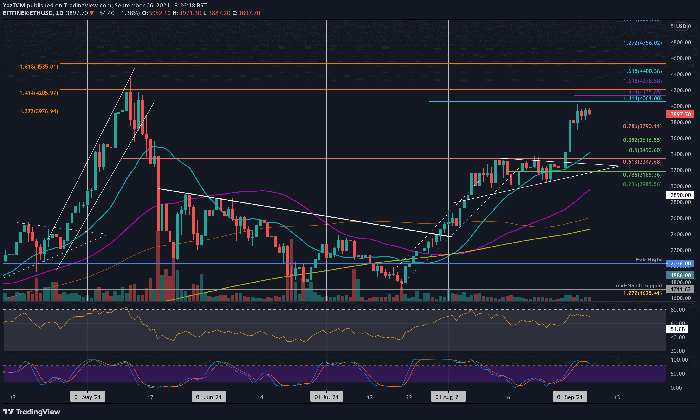Bitcoin crosses $100K again, marking a significant milestone in the volatile cryptocurrency landscape. After months of fluctuating prices, the world’s leading digital asset has surged back above this pivotal threshold, largely driven by easing geopolitical tensions and a resurgence in institutional demand. Market analysts note that this rally comes amidst a backdrop of favorable macroeconomic conditions, making it a beacon of optimism for investors. With Bitcoin’s price analysis pointing towards renewed confidence in cryptocurrency market trends, particularly around Bitcoin exchange-traded funds (ETFs), the future seems promising. As Bitcoin continues to gain traction, the increasing inflows into these ETFs signal a strong commitment from institutional players, suggesting that the cryptocurrency market is poised for further growth.
The recent surge in the leading cryptocurrency has captured the attention of investors and market analysts alike, as Bitcoin sees a remarkable recovery above the $100K mark. This resurgence, fueled by shifts in macroeconomic conditions, highlights the growing interest among institutional investors and a robust demand for digital assets. Notably, the inflow of capital into Bitcoin-related exchange-traded funds reflects a strategic interest rather than opportunistic buying, signifying a shift in how investors engage with the digital currency landscape. Amid favorable market conditions, observers are keenly analyzing Bitcoin’s price trends to gauge the longevity of this upswing. As the cryptocurrency sector evolves, its implication on market dynamics remains an exciting area of focus for both seasoned investors and newcomers.
Bitcoin Surges Past $100K as Economic Climate Improves
The recent surge of Bitcoin beyond the $100,000 mark marks a significant milestone in its market journey. This impressive rally comes as a result of easing tensions between the United States and China, coupled with a bolstering of the macroeconomic environment. Analysts have reported that these factors contribute to growing institutional confidence, driving both demand and capital inflows into the cryptocurrency market, thereby enhancing investor sentiment. It is imperative to note that such price movements not only signify market recovery but also highlight Bitcoin’s resilience as a leading digital asset.
As macroeconomic conditions become more favorable, Bitcoin price analysis reveals that this growth is not merely a speculative spike but rather a reflection of robust underlying support. Institutional demand has remained steady, with significant participation from large investors and corporations who are increasingly recognizing Bitcoin as a viable asset class. This influx of institutional investment and the positive shift in economic indicators have led to a more liquid market environment, which supports the likelihood of Bitcoin maintaining its upward momentum.
Factors Driving Bitcoin’s Resurgence in 2025
Several key factors are simultaneously driving Bitcoin’s resurgence in 2025, particularly in light of shifting geopolitical dynamics and economic stability. Analysts point out that easing tariff tensions have helped to create a conducive backdrop for risk assets like Bitcoin to thrive. The Federal Reserve’s supportive stance on interest rates further strengthens the appeal of cryptocurrencies as an alternative investment, leading to substantial capital allocations from both institutional players and retail investors.
Moreover, Bitcoin ETF inflows have become a notable catalyst for the market, indicating a solid consumer appetite for Bitcoin exposure through regulated channels. The growing interest in U.S. spot Bitcoin ETFs signifies a mature market, reflecting an increase in the steady allocation of Bitcoin in diversified portfolios rather than opportunistic buying based on short-term price movements. This institutional-level engagement suggests a paradigm shift towards a more sophisticated understanding of Bitcoin as a long-term investment.
Understanding Bitcoin Market Trends Post-$100K
The recent price action of Bitcoin crossing the $100K barrier underscores a transformation in market trends that will shape the future of cryptocurrency. A critical analysis of Bitcoin market trends shows that this surge is not an isolated event but part of a broader trajectory influenced by favorable macroeconomic conditions and institutional participation. Investors are increasingly looking at Bitcoin as a hedge against inflation and economic uncertainty, prompting a long-term bullish sentiment that could lead to the establishment of higher price floors.
Additionally, Bitcoin’s ability to rebound after lingering below the $75,000 range demonstrates its capacity to attract attention even amidst market fluctuations. As analysts track Bitcoin’s volatility and correlate it with institutional demand, observations suggest that sustained capital inflows into Bitcoin ETFs will support further price increases, solidifying Bitcoin’s status as a cornerstone of the cryptocurrency market. This evolving landscape invites both seasoned and new investors to participate in the digital economy, harnessing Bitcoin’s potential as a significant investment vehicle.
The Role of Institutional Demand in Bitcoin’s Growth
Institutional demand plays a pivotal role in propelling Bitcoin’s growth trajectory, especially evident during its latest surge past the $100K mark. The continued influx of capital from institutional investors showcases a shift towards recognizing Bitcoin as a legitimate store of value and strategic portfolio asset. This demand is evident through Bitcoin ETFs that are gaining traction, highlighting a greater willingness of institutional investors to enter the cryptocurrency space in a structured manner.
Moreover, the strategic allocations made by these investors reflect an understanding of Bitcoin’s potential as a safe haven amidst rising inflation and political uncertainties. The observed patterns of significant inflows into Bitcoin ETFs indicate that institutions are not merely reacting to market trends but are instead committing to Bitcoin as part of a comprehensive investment strategy that seeks to balance risk and reward. As institutional players step into the market, their influence shapes both the liquidity and valuation of Bitcoin, drawing more attention from retail investors who are keen to capitalize on this trend.
Evaluating Cryptocurrency Resurgence in 2025
The resurgence of cryptocurrencies in 2025, driven by the bullish momentum of Bitcoin, reflects an underlying shift in investor attitudes toward digital assets. With Bitcoin setting new milestones, the overall cryptocurrency market has witnessed a revitalization characterized by increased participation and market confidence. Factors such as reduced regulatory uncertainty, a clearer understanding of digital asset use cases, and advancements in blockchain technology are supporting this resurgence, leading to a more favorable view of cryptocurrencies as a legitimate asset class.
In this context, Bitcoin serves as a bellwether for the broader cryptocurrency market, influencing price movements across altcoins and driving interest among new investors. This resurgence is not only seen through valuations but also in increased trading volumes and capital flows into various digital currencies, indicating a healthy market environment. The positive sentiment surrounding Bitcoin and its recent ATH developments can act as a catalyst for continued growth within the entire cryptocurrency ecosystem.
Impacts of Macroeconomic Conditions on Bitcoin Prices
Macroeconomic conditions significantly impact Bitcoin prices, and the current economic climate appears favorable for the cryptocurrency’s growth. The easing of tensions between major economies and supportive monetary policies from central banks create an environment conducive to increased investment in risk assets like Bitcoin. As concerns related to inflation and geopolitical instability subside, investors are more inclined to explore digital currencies, resulting in upward price pressure.
Moreover, analysts highlight that macro catalysts play an essential role in Bitcoin price development as institutional players leverage such favorable conditions to increase their holdings. The ongoing assessment of Bitcoin’s price movements against macroeconomic trends reveals a stronger correlation between positive economic signals and Bitcoin surges. This relationship fortifies the view that macroeconomic conditions will continue influencing Bitcoin’s price trajectory, potentially allowing it to achieve and maintain higher price levels in the foreseeable future.
The Future of Bitcoin ETFs and Market Dynamics
The future of Bitcoin ETFs looks promising as institutional demand continues to rise, fostering a more robust market structure that attracts diverse investors. These ETFs are not just vehicles for speculation; they provide a secure option for institutions to gain exposure to Bitcoin, contributing to enhanced market legitimacy and stability. As more Bitcoin ETFs receive approvals and attract significant inflows, the market can expect increased liquidity and decreased volatility, making Bitcoin an appealing choice for conservative investors.
In analyzing market dynamics surrounding Bitcoin ETFs, a notable trend emerges: inflow patterns suggest that institutional buying behaviors are shifting towards long-term strategies rather than short-lived opportunistic trades. This trend signals a maturation of the cryptocurrency market, where perceived value and capital allocation strategies take precedence. As Bitcoin continues to garner institutional backing through ETFs, its integration into mainstream financial portfolios will reshape investor engagement with Bitcoin and other cryptocurrencies.
Understanding Bitcoin’s Realized Cap Impact
Bitcoin’s realized cap plays a vital role in understanding market dynamics and price trends. As Bitcoin’s realized cap hits new all-time highs, it indicates a significant amount of capital is entering the market, reflecting investor confidence and profitability. The realized cap metric serves as a barometer for assessing the aggregate costs of Bitcoin held by investors, providing insights into market sentiment and liquidity. An increasing realized cap suggests sustained demand, essential for driving long-term price appreciation.
Furthermore, the drop in unrealized losses from over 5 million coins to just 0.7 million amid the recent price recovery emphasizes the shifting sentiment in the market. As more investors become profitable, confidence grows, fueling further buying activity. The correlation between realized cap and Bitcoin price performance highlights the importance of monitoring this metric to gauge potential future movements, reinforcing the view that a strong realized cap can act as a springboard for sustained price growth.
Trends in Bitcoin Price Analysis for Investors
As Bitcoin’s price rises beyond the $100K threshold, investors must closely analyze market trends to effectively gauge potential price movements. Bitcoin price analysis suggests that real-time data, coupled with historical trends, can provide valuable insights into potential market behavior. Chart patterns, support, and resistance levels are becoming increasingly important for traders looking to make informed decisions based on both technical and fundamental analyses.
Moreover, understanding Bitcoin’s interaction with macroeconomic factors and institutional activities will play a crucial role in future price projections. Investors are advised to remain vigilant of external indicators, such as geopolitical developments and monetary policy shifts that can significantly impact Bitcoin’s performance. Continuous monitoring and analysis are necessary for navigating the complexities of the cryptocurrency market, enabling investors to capitalize on opportunities as they arise.
Frequently Asked Questions
What factors contributed to Bitcoin crossing $100K again?
Bitcoin crossed the $100K mark due to easing tariff tensions, a resurgence of institutional demand, and favorable macroeconomic conditions. Analysts at Bitfinex highlighted that these factors have created a positive environment, leading to increased BTC confidence and capital inflows.
How does Bitcoin’s price analysis reflect its potential to maintain above $100K?
Bitcoin’s price analysis shows a robust recovery, primarily driven by significant capital inflows and institutional support. The recent surge towards $100K indicates strong market participation, suggesting that BTC could maintain its price as long as macroeconomic factors remain favorable.
What role do Bitcoin ETF inflows play in its recent price surge past $100K?
The massive inflows into Bitcoin ETFs have played a crucial role in BTC’s recent price surge past $100K. These inflows indicate steady institutional demand, helping to decouple short-term market volatility from long-term investment strategies.
Are current Bitcoin market trends indicative of a long-term bullish phase?
Current Bitcoin market trends, such as the renewed capital inflows and positive institutional demand, suggest a potential long-term bullish phase. As BTC continues to receive backing from institutional investors, it may solidify its position above $100K.
What implications does Bitcoin’s resurgence have for future cryptocurrency market trends?
Bitcoin’s resurgence above $100K could signal a wider cryptocurrency resurgence, encouraging investors to explore various altcoins and blockchain technologies. This momentum may inspire confidence in the overall market and fuel further investments across the cryptocurrency spectrum.
How does institutional demand influence Bitcoin’s ability to reclaim the $100K level?
Institutional demand has a significant influence on Bitcoin’s ability to reclaim and sustain the $100K level. Increased allocations from institutions suggest a growing belief in BTC’s long-term viability, which can stabilise its price and attract more investors into the market.
| Key Points | Details |
|---|---|
| Bitcoin’s Price Movement | Bitcoin reclaimed the $100,000 mark, hitting levels just 3.6% shy of its all-time high (ATH). This surge signifies a recovery for the first time in over three months. |
| Macroeconomic Conditions | Easing tariff tensions between China and the U.S., along with a positive Federal Reserve outlook, are providing a supportive environment for Bitcoin’s price increase. |
| Capital Inflows | Renewed capital inflows have been observed, enhancing market liquidity. Bitcoins realized cap has reached an ATH of $889 billion, showing a 2.1% increase in the past month. |
| Institutional Demand | U.S. spot Bitcoin ETFs have seen significant inflows, suggesting steady institutional demand rather than opportunistic buying, indicating a long-term bullish trend. |
Summary
Bitcoin crosses $100K again, showcasing the cryptocurrency’s resilience amid favorable macroeconomic conditions. Analysts predict that the recent surge is fueled by easing geopolitical tensions, substantial capital inflows, and strong institutional demand, setting the stage for potential new all-time highs. As Bitcoin continues to attract investors both in the retail and institutional spheres, the outlook remains optimistic, solidifying its place as a leading asset in the financial ecosystem.
Bitcoin crosses $100K, marking a significant milestone in its ongoing journey through the cryptocurrency market. This remarkable resurgence can largely be attributed to easing macroeconomic tensions and surging institutional demand, resonating through recent Bitcoin price analysis. The cryptocurrency has not only reclaimed this pivotal price threshold but is now just a hair’s breadth away from its all-time high, sparking interest in Bitcoin market trends. As reported by Bitfinex, the influx of capital and improved economic indicators have reinvigorated hopes among investors, suggesting a broader cryptocurrency resurgence may be underway. Investors and analysts alike are closely monitoring the implications of rising Bitcoin ETF inflows, which have shown a strong correlation with the asset’s recent gains.
The recent leap in Bitcoin’s market value has captured the attention of financial enthusiasts, signaling a return to confidence among investors. With the digital currency breaking the $100,000 barrier, it’s clear that a combination of positive economic conditions and strong market liquidity is reshaping the landscape. Insights into Bitcoin’s revitalization reveal increasing institutional participation, which mirrors broader trends across the cryptocurrency space. The dynamic nature of asset allocation is also visible in the burgeoning flows into Bitcoin ETFs, which offer a regulated gateway for traditional investors. This collective interest hints at a growing acceptance of digital currencies as a staple in investment portfolios.















